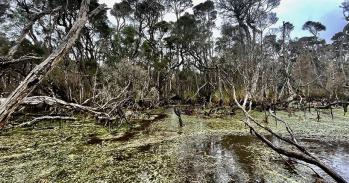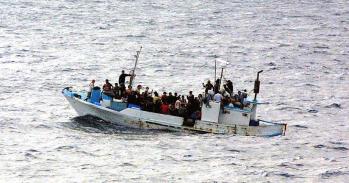
First study to model the organisation behind trade in illegal border crossings shows no “Mafia-like” monopoly of routes from Africa into Europe via Mediterranean. Instead, myriad independent smugglers compete in open markets that have emerged at every stage of the journey.
First study to model the organisation behind trade in illegal border crossings shows no “Mafia-like” monopoly of routes from Africa into Europe via Mediterranean. Instead, myriad independent smugglers compete in open markets that have emerged at every stage of the journey.
This is a far cry from how Mafia-like organisations operate
Paolo Campana
Latest research shows a lack of overarching coordination or the involvement of any “kingpin”-style monopolies in the criminal operations illegally transporting people from the Horn of Africa into Northern Europe via Libya.
Instead, transnational smuggling routes were found to be highly segmented: each stage a competitive marketplace of “independent and autonomous” smugglers – as well as militias and kidnappers – that must be negotiated by migrants fighting for a life beyond the Mediterranean Sea.
The first “network analysis” of this booming criminal enterprise suggests that successful smugglers need a reputation among migrants – and that removing any individual smuggler will only result in rivals immediately seizing their “market share”.
Dr Paolo Campana from Cambridge University’s Institute of Criminology conducted the research using evidence from the 18-month investigation by Italian prosecutors that followed the Lampedusa shipwreck, in which 366 people lost their lives.
The work included data from wiretapped telephone conversations between smugglers at all stages, testimonies collected from migrants, interviews with police task force members, and background information on offenders.
“The smuggling ring moving migrants from the Horn of Africa to Northern Europe via Libya does not appear to have the thread of any single organisation running through it,” said Campana, whose findings are published today in the European Journal of Criminology.
“This is a far cry from how Mafia-like organisations operate, and a major departure from media reports claiming that shadowy kingpins monopolise certain routes.”
In fact, it was the Anti-Mafia unit with the Palermo Prosecutor’s Office initially tasked with investigating smuggling operations on both sides of the Mediterranean in the wake of the Lampedusa disaster in October 2013.
Campana points out that they found no evidence of any involvement from the Sicilian Mafia at the time, even through payment of protection money – despite Sicily being a key stage in the smuggling route.
The two indictments prepared by the Palermo unit – totalling some 800 pages – formed a major part of the dataset Campana combed through to code all possible data points: references to times, names, events, exchanges, locations and so on.
Overall, 292 actors (not including migrants) were identified as part of the Lampedusa smuggling ring. 95% were male smugglers operating along the main route, from the Horn of Africa to the Nordic nations in northern Europe – where many migrants hoped to find refuge – via Libya and Italy.
However, the network also extended to Dubai, Israel, Canada, Turkey, Germany and the UK, and included those who kidnap for ransom in the deserts of Libya, and Tripoli militiamen who take bribes to let migrants out of detention centres.
“People specialise,” said Campana. “There was a clear separation between those providing smuggling services, those kidnapping for ransom, and those, like the militias, ‘governing’ spaces and supplying protection.”
He also detected signs of rudimentary hierarchy among smugglers in some stages of the route, which roughly divide into ‘organiser’ and ‘aide’.
“Organisers are individuals who give orders but don’t receive them, while aides are highly dependent on organisers for their activities. Organisers make up some 15% of the smuggling network and the remaining 85% occupy a lower ranking aide position.”
The network models built by Campana show that those who operate in the same stage of the journey are almost seven times more likely to have some link with each other. “Even in a network that traverses the hemispheres, it is the local dimension that is still crucial,” he said.
Moreover, Campana found that those who share the same network position as either organiser or aide are three times less likely to have any tie. “There is little contact between fellow organisers, reinforcing the impression of smugglers as free-trading independents. Business opportunities tear coordination apart,” he said.
Indeed, a focused analysis of a sub-network of 28 smugglers revealed that those based in Italy who tapped directly into the Libyan ‘marketplace’ had very little contact with each other.
Wiretaps and testimonials suggest that migrants have to pay separate vendors for each leg of the journey. Payment was often done in advance though Hawala, an informal money transfer system based on trust.
One wiretap reveals a charge of $3600 for a couple to cross the Mediterranean. Another wiretapped smuggler charges €150 per person for a car trip from Sicily to Rome.
“Reputation is crucial in a competitive market, and the wiretaps show how much value smugglers place on their reputation,” said Campana.
One smuggler was recorded reproaching another for overcrowding a boat, comparing it to the way a dirty bathroom reflects badly on everyone who shares the house.
In fact, the wiretaps reveal that the loss of life in the Lampedusa disaster led to compensation being paid to families by smugglers scared of losing future business.
“Authorities may wish to deliberately tarnish the reputation of smugglers in order to shut down their business,” said Campana.
“Criminal justice responses require the adoption of coordinated tactics involving all countries along the route to target these localised clusters of offenders simultaneously.
“This is a market driven by exponential demand, and it is that demand which should be targeted. Land-based policies such as refugee resettlement schemes are politically difficult, but might ultimately prove more fruitful in stemming the smuggling tide than naval operations.”

The text in this work is licensed under a Creative Commons Attribution 4.0 International License. For image use please see separate credits above.




